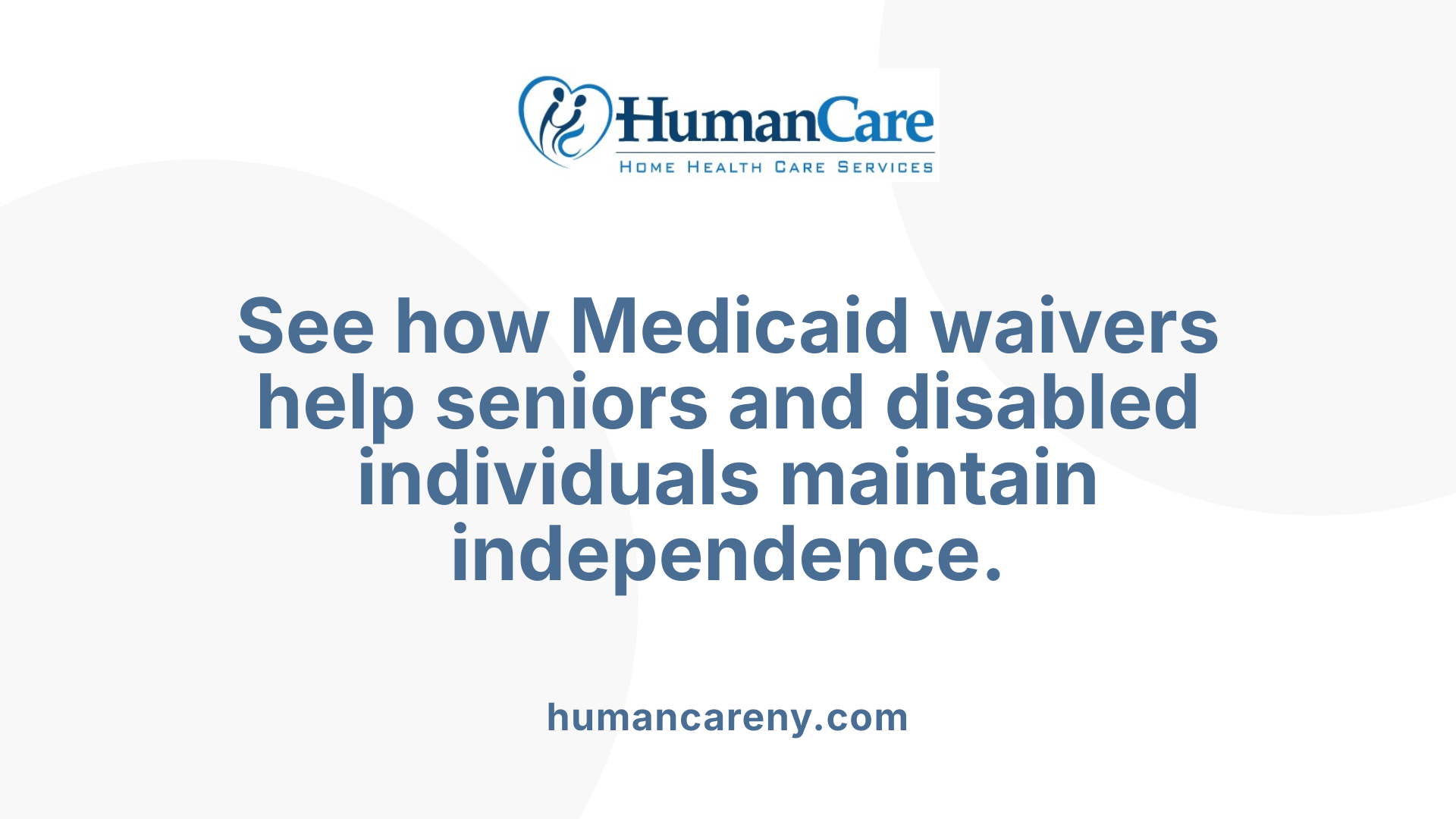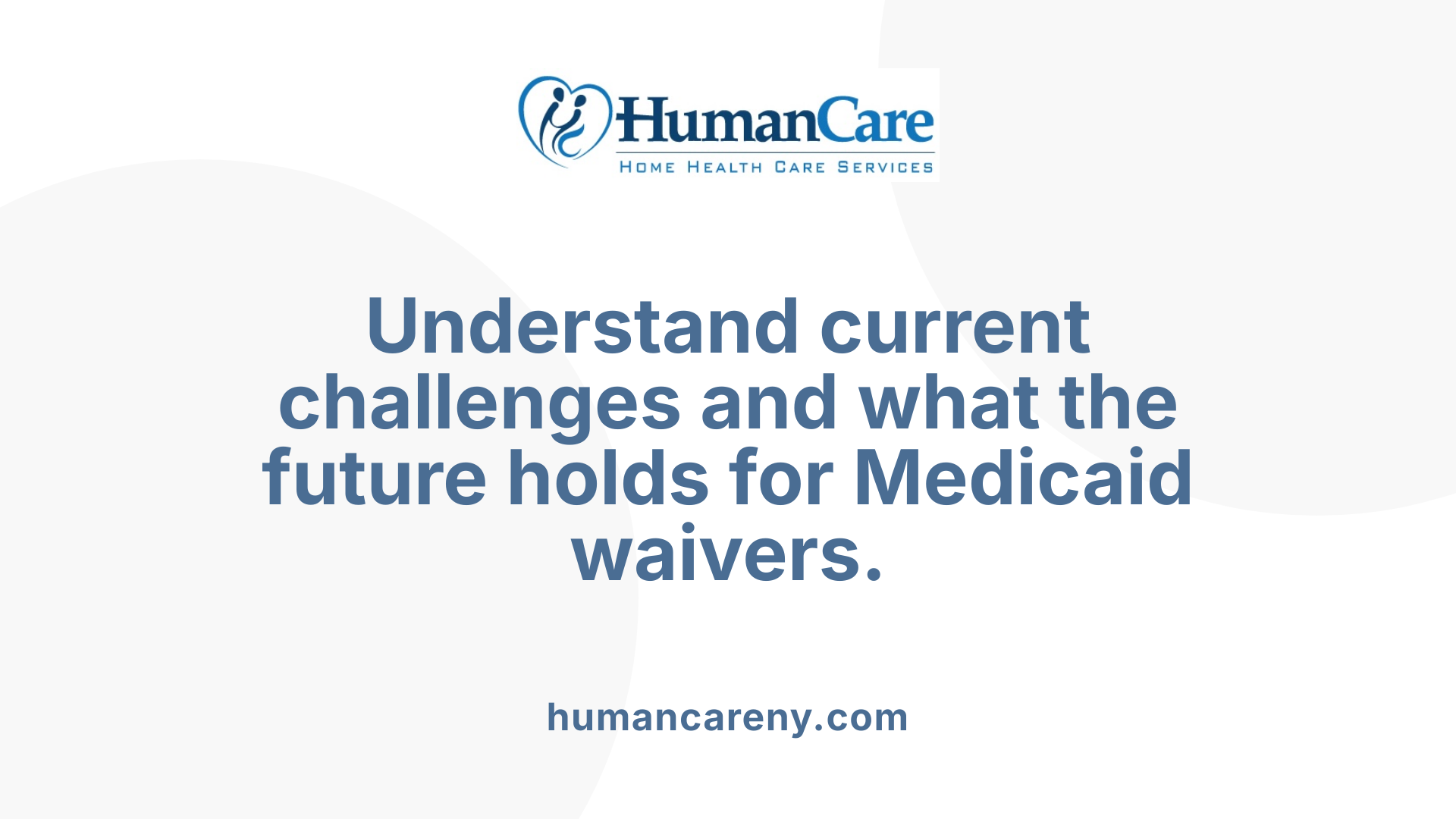The importance of Medicaid waiver programs in home health care
How Medicaid Waivers Revolutionize Home Health Care

Understanding Medicaid Waiver Programs
Medicaid waiver programs have become a vital component in providing home health care services, especially for the elderly and individuals with disabilities. These waivers enable states to offer personalized, community-based care options beyond traditional institutional settings, helping recipients maintain independence in their own homes. This article delves into the significance of Medicaid waivers, their structure, and their impact on home health care delivery nationwide.
What Are Medicaid Waiver Programs and Their Purpose?
Definition of Medicaid waivers
Medicaid waivers are special permissions granted by the federal government to states, allowing them to modify certain Medicaid rules. These waivers enable states to offer services not typically covered under standard Medicaid, such as in-home care, to help individuals avoid institutionalization. Waivers are designed to be cost-neutral, meaning the total costs cannot exceed the cost of equivalent care in institutional settings.
Purpose and benefits
The primary goal of Medicaid waiver programs is to provide tailored home and community-based services (HCBS) that support various populations, including the elderly, people with disabilities, and those with chronic health conditions. These services empower individuals to live as independently as possible within their homes or communities, enhancing their well-being and quality of life. Benefits include access to personal care, case management, respite care, and other supportive services that promote autonomy while reducing dependence on long-term care facilities.
Federal and state role
Medicaid is a joint federal-state program, and waivers are developed by states under federal guidelines. States propose, administer, and periodically renew these waiver programs, demonstrating cost-effectiveness and ensuring protections for participants' health and welfare. The federal government reviews and approves waivers, giving states flexibility to meet the unique needs of their residents while adhering to overarching Medicaid principles.
Key Types of Medicaid Waiver Programs Supporting In-Home Care

What Are HCBS Waivers?
Home and Community-Based Services (HCBS) Waivers are Medicaid programs that allow states to provide a range of non-institutional services to eligible individuals. These waivers support in-home and community care to help people with disabilities, seniors, and those with chronic conditions live independently instead of in long-term care facilities. Services include case management, homemaker assistance, personal care, respite care, and adult day health services. California’s HCBS Waivers are a critical part of this, helping maintain the health and welfare of participants with personalized care plans.
What Is the Assisted Living Waiver?
The Assisted Living Waiver (ALW) targets seniors and disabled adults who require assistance but prefer to live in an assisted living environment instead of a nursing home. This California-specific waiver provides in-home and community-based supports tailored to help participants maintain their independence while receiving necessary care and supervision. It is an important option that complements other waiver programs by offering tailored housing-related services alongside medical and personal care.
How Do Section 1115 and 1915(c) Waivers Differ?
California operates Medicaid waivers under different authorities, notably Section 1115 Demonstration Waivers and 1915(c) waivers. Section 1115 waivers offer flexibility for broader program design innovations, often integrating care coordination and combining physical, behavioral, and social services, as seen in initiatives like CalAIM. On the other hand, 1915(c) HCBS waivers focus specifically on home and community-based services, requiring states to demonstrate cost neutrality with institutional care and ensure the health and welfare of participants through individualized plans. Both types expand access to home care while meeting federal guidelines.
What Are State Plan Options for In-Home Care?
Beyond waivers, Medicaid State Plans include options such as Community First Choice and Self-Directed Personal Assistance Services. These provide a framework for states to offer home care services directly without needing waivers, allowing individuals and families to manage or direct their own care. State plan services can complement waiver programs by covering a variety of in-home supports, including paid family caregiving, and are an important component of the overall Medicaid home care landscape.
| Waiver/Program | Primary Focus | Key Services Provided |
|---|---|---|
| HCBS Waivers | Community-based long-term care | Personal care, case management, respite, adult day care |
| Assisted Living Waiver | Assisted living supports | In-home services, personal assistance, supervision |
| Section 1115 Waivers | Flexible demonstration programs | Integrated care, behavioral and social supports |
| 1915(c) Waivers | Home and community-based services | Cost-neutral home care, individualized care plans |
| State Plan Options | Direct Medicaid-covered services | Self-directed assistance, family caregiving programs |
Eligibility and Enrollment Processes for Medicaid Waivers

What Are the Eligibility Criteria for Medicaid Waivers?
Eligibility for Medicaid waivers generally hinges on age, disability status, and medical need. Specifically, applicants must typically qualify for institutional care but prefer to receive services at home or in their communities. States may impose unique care level standards tailored to the population they serve, such as seniors, persons with disabilities, or individuals with specialized health conditions.
What Are the Income and Asset Limits?
To qualify for these waivers, applicants must meet income and asset thresholds that vary by state and program. For instance, standard Medi-Cal income limits for HCBS waivers hover around $2,901 per month, while regular Medicaid limits may be closer to $967 or $1,304.17 monthly as of 2025. Asset caps are often near $2,000 but can differ. These financial criteria help ensure that assistance targets those most in need.
How Does the Assessment and Application Process Work?
Prospective participants undergo detailed assessments coordinated by program administrators to establish medical eligibility and care needs. This process includes functional and medical evaluations to confirm that waiver supports are appropriate. Once assessed, applicants submit documentation through their state Medicaid office to proceed with enrollment.
What Role Do Medicaid Planners Play?
Navigating the complexities of Medicaid waiver applications is frequently challenging, especially given varying state policies and waiting lists. Professional Medicaid planners offer invaluable assistance in evaluating eligibility, organizing necessary paperwork, and guiding families through application steps. Their expertise helps simplify the process and optimize access to available waivers.
Services Provided Through Medicaid Home and Community-Based Services (HCBS) Waivers
What Services Are Included in HCBS Waivers?
Medicaid Home and Community-Based Services (HCBS) waivers offer a broad spectrum of both non-medical and medical services designed to help individuals remain safely and comfortably in their homes or communities. The range of services can be tailored to meet the unique needs of eligible individuals, including seniors, people with disabilities, and those with chronic health conditions.
Case Management
A central service provided under HCBS waivers is case management. This involves coordinating healthcare and social services to ensure that individuals receive appropriate care. Case managers work closely with the participant to develop a personalized care plan and monitor ongoing needs and service delivery.
Personal Care and Homemaker Services
Personal care and homemaker services are vital components of HCBS waivers. These services include assistance with daily living activities such as bathing, dressing, meal preparation, and housekeeping. Homemaker services help maintain a safe and clean environment, while personal care workers support individuals in their routine personal needs—promoting independence and quality of life.
Respite Care and Adult Day Care
Respite care services allow primary caregivers to take temporary breaks by providing short-term relief through in-home support. This service is essential for reducing caregiver stress and maintaining family stability. Additionally, adult day care services offer social, therapeutic, and recreational activities in a community setting, helping participants stay engaged and connected while providing support during daytime hours.
Together, these services under HCBS waivers play a crucial role in supporting individuals to live independently, enhancing their well-being with coordinated, person-centered care.
Medicaid Waivers as a Means to Preserve Independence at Home

Avoiding Long-Term Institutionalization
Medicaid waiver programs are essential tools that help individuals with disabilities and the elderly receive care in their own homes or community settings rather than being placed in long-term care facilities. These waivers enable states like California to provide services tailored to individual needs, offering alternatives to institutional care. By doing so, waivers help reduce the physical, emotional, and financial impacts that come with institutionalization.
Supporting Autonomy and Well-Being
Waivers such as California's Home and Community-Based Services (HCBS), Assisted Living Waivers (ALW), and the Multipurpose Senior Services Program (MSSP) emphasize preserving the autonomy and well-being of seniors and disabled persons. These programs provide a range of supportive services—such as home health aides, personal care, case management, homemaker services, and respite care—that empower individuals to maintain daily activities and live independently. This person-centered approach ensures that participants remain active in their communities while receiving the care they need.
Individualized Care Planning
A hallmark of Medicaid waivers is the development of individualized plans of care. Eligibility assessments are conducted to determine the specific needs of each participant, ensuring services align with their unique preferences and medical requirements. Care plans are designed to protect health and welfare while maintaining cost-efficiency compared to institutional care. Additionally, programs allow for self-directed services or support through service coordinators, promoting choice and control over care. This tailored approach fosters greater satisfaction and better health outcomes for those served.
These Medicaid waiver programs embody a commitment to promoting independence, dignity, and quality of life for vulnerable populations by offering flexible, community-based care options that align with individuals’ wishes and needs.
Medicaid Waivers and Family Caregiver Support

How Are Family Caregivers Compensated Through Medicaid Waivers?
Medicaid waivers provide a valuable pathway for compensating family caregivers who play a significant role in home and community-based care. Many states allow relatives and friends—such as spouses and adult children—to be paid caregivers under Medicaid programs, with specific rules varying by state.
Financial support often comes through programs embedded in HCBS Medicaid Waivers (under Section 1915(c)) and 1115 Demonstration Waivers that cover services like personal care and respite care. These waivers allow family caregivers to receive payment for the services they provide, thereby encouraging care in home settings and reducing institutionalization.
What Consumer-Directed Care Options Exist?
Consumer-directed care options give beneficiaries more control over who provides their care and how their services are managed. Through these models, individuals can hire family members as paid caregivers, select services according to their preferences, and manage their care budgets.
All 50 states and the District of Columbia offer some form of Medicaid-funded consumer-directed personal care assistance programs. Examples include HCBS State Plan options and the Community First Choice program, which support autonomy and person-centered planning.
What Are Programs Like Structured Family Caregiving and the Caretaker Child Exception?
Structured Family Caregiving (SFC), also known as adult foster care or adult family living, is designed to financially support and train unpaid primary caregivers living with the Medicaid beneficiary. This program recognizes caregivers' vital contributions by providing them with compensation and education.
Another notable program is the Caretaker Child Exception, which allows an adult child who has lived with and cared for a parent to be included in Medicaid planning, often involving home transfer arrangements as compensation. This exception can help families maintain stability and continue caregiving without financial hardship.
Together, these programs and options underscore Medicaid waivers' commitment to supporting family caregivers, boosting care quality, and enabling individuals to remain in their homes with dignity and choice.
State Variability and Customization in Medicaid Waiver Programs
How do Medicaid waiver programs differ across states?
Medicaid waiver programs exhibit considerable variation from state to state, reflecting local priorities and demographics. While all 50 states and the District of Columbia offer some form of home- and community-based service (HCBS) waivers, the specific programs, eligibility criteria, and covered services can vary widely. For example, states operate waivers under different federal authorities such as 1915(c) waivers and 1115 demonstration waivers. These waivers are periodically renewed, expanded, or sunsetted, leading to dynamic program offerings.
Which populations are targeted by Medicaid waivers?
States typically design waiver programs to serve specific groups with specialized needs. Common target populations include elderly adults requiring long-term care, individuals with physical disabilities, and people with developmental disabilities like autism spectrum disorder. Some waivers specifically address needs related to traumatic brain injuries, substance use disorders, or AIDS, while others have broad eligibility covering various chronic or disabling conditions. This focus ensures tailored support that promotes independence and community living.
How flexible are waiver eligibility and services?
There is notable flexibility in how states define eligibility and deliver services through waiver programs. Eligibility usually requires meeting state-specific criteria, often tied to the need for institutional-level care but allowing individuals to remain at home or in community settings. States may waive certain Medicaid rules such as income, resource limits, or service comparability to better fit local needs. Services offered under waivers are diverse and may include case management, homemaker services, home health aide support, respite care, adult day programs, and assistive technologies.
Additionally, many states incorporate person-centered planning and self-directed service options, enabling participants to choose or manage their own care. This flexibility promotes a more individualized approach aligned with each person's preferences. States also have varying policies regarding compensating family caregivers, which ranges from allowing payment for relatives to implementing programs like Structured Family Caregiving.
| State Variability Aspect | Description | Example or Note |
|---|---|---|
| Federal Waiver Types | 1915(c), 1115 demonstration waivers, State Plan Options | Different rules and renewal cycles across states |
| Target Populations | Seniors, physical disabilities, developmental disabilities | Autism-specific waivers exist in some states |
| Eligibility Criteria | Income, assets, functional assessments | Allows for waivers of certain Medicaid rules |
| Services Offered | Home care aides, adult day health, respite, personal care | Services tailored to individual needs |
| Caregiver Compensation | Family caregiver payment varies by state | Includes self-directed and structured caregiving |
This state-specific customization enables Medicaid waiver programs to address diverse community needs while supporting individuals in remaining independent and integrated within their homes and communities.
The Role of Coordinated Care and Initiatives like CalAIM
What is the CalAIM Initiative?
The CalAIM (California Advancing and Innovating Medi-Cal) initiative is a comprehensive statewide effort to enhance the coordination and integration of care within Medi-Cal services. It aims to unify physical health, behavioral health, and social support systems to offer seamless assistance to participants.
How Does CalAIM Promote Integrated Care Models?
CalAIM fosters integrated care by bridging gaps between traditionally separate services, allowing Medi-Cal recipients to receive holistic support. This integration means that an individual’s medical treatment, mental health services, and social needs—such as housing or nutrition—are coordinated together rather than handled in silos.
Why is Coordination Between Physical, Behavioral, and Social Services Important?
Coordinating these diverse services prevents fragmented care and improves outcomes for seniors and people with disabilities. When physical health providers collaborate with behavioral health specialists and social service agencies, they can address complex needs more effectively, reducing hospital visits and enhancing quality of life.
What is a Person-Centered Approach?
Person-centered care is a fundamental principle under CalAIM, focusing on tailoring services to meet each individual’s unique preferences, conditions, and goals. This involves working closely with participants to develop personalized care plans that empower independence and respect dignity.
How Does CalAIM Affect Medi-Cal Waiver Programs?
CalAIM supports waiver programs by encouraging care coordination among multiple providers and services through managed care plans. These efforts promote efficiency, ensure continuity of care, and improve the overall well-being of vulnerable populations receiving in-home and community-based services.
Challenges Facing Medicaid Waiver Programs and Future Outlook

What are the challenges related to waitlists and limited spots for Medicaid waiver programs?
Medicaid waiver programs often face significant waitlists due to limited availability of spots. These programs, which provide critical in-home and community-based services, cannot always accommodate the demand from eligible seniors, people with disabilities, and others needing support. The application process can involve extensive medical and functional assessments, and waiting times can span months or even years, leaving many prospective beneficiaries without timely access to essential services.
How might potential funding cuts and policy changes impact Medicaid waivers?
Proposed reductions in federal Medicaid spending, such as those suggested by the House of Representatives, could severely impact Medicaid waiver programs. Funding cuts may reduce access to home care services, limit the availability of supports for family caregivers, and strain the workforce providing in-home care. Service reductions or limitations could threaten the independence and well-being of vulnerable populations who rely on these programs to avoid institutionalization.
What workforce and service capacity issues do these programs face?
Medicaid waiver programs depend heavily on a skilled workforce to deliver home and community-based care. However, there are ongoing challenges related to recruiting and retaining qualified caregivers, including paid family members and home health aides. Capacity constraints can lead to inconsistent service availability and quality. Furthermore, increased demand for Medicaid home care services exacerbates these issues, requiring coordinated efforts to expand training, support, and retention strategies for care providers.
Together, these challenges highlight the necessity for sustained funding, improved program capacity, and strategic policy interventions to ensure Medicaid waiver programs continue to support the independence and health of millions of Americans in need.
The Broader Impact of Medicaid Waivers on Home Health Care Nationwide
How significant is Medicaid in funding home care services in the U.S.?
Medicaid plays a crucial role in funding home care, covering about two-thirds of all home care spending in the United States as of 2022. Each year, approximately 4.5 million people receive Medicaid-funded home care, highlighting the program’s vast reach and importance. This substantial investment reflects Medicaid’s commitment to supporting individuals with disabilities and chronic conditions in community settings rather than institutional care.
How widespread is coverage of Medicaid home care across states and populations?
Nearly every U.S. state, including the District of Columbia and Puerto Rico, offers Home and Community-Based Services (HCBS) waivers, with about 257 active waiver programs nationwide. These waivers serve diverse populations such as seniors, people with disabilities, and individuals with specific health conditions including developmental disabilities and traumatic brain injuries.
States tailor their programs with various waivers under federal authorities like 1915(c) and 1115 demonstrations. This flexibility allows funding for a variety of services including personal care, homemaker services, adult day care, and respite care. Managed care plans administer most Medicaid home care services in all but 11 states, helping coordinate care for enrollees.
What is the long-term significance of Medicaid waivers for health systems?
Medicaid waivers offer a cost-effective alternative to institutional care. By demonstrating cost neutrality compared to facility-based services, waivers enable individuals to receive person-centered care in their homes or communities, enhancing quality of life.
The waivers also promote independence and help reduce reliance on more expensive long-term care facilities, thereby easing financial pressures on public health systems. Moreover, initiatives like California’s CalAIM underscore the trend toward integrating physical health, behavioral health, and social support through coordinated care models.
However, proposed federal budget cuts to Medicaid raise concerns that access to home care services may be reduced, potentially impacting workforce stability and family caregiver support. Maintaining robust Medicaid home care programs is thus vital for sustaining community-based long-term care and meeting the needs of vulnerable populations nationwide.
The Critical Role of Medicaid Waiver Programs in Home Care
Medicaid waiver programs have transformed how home health care is delivered, enabling millions to live with dignity and independence outside institutional settings. By providing tailored services, supporting family caregivers, and coordinating care through innovative initiatives, these waivers play an indispensable role in the healthcare ecosystem. Despite challenges such as funding pressures and waitlists, continued support and expansion of Medicaid waiver programs remain essential for meeting the diverse needs of vulnerable populations, ultimately ensuring that quality care is accessible within the comfort of home.



































































































